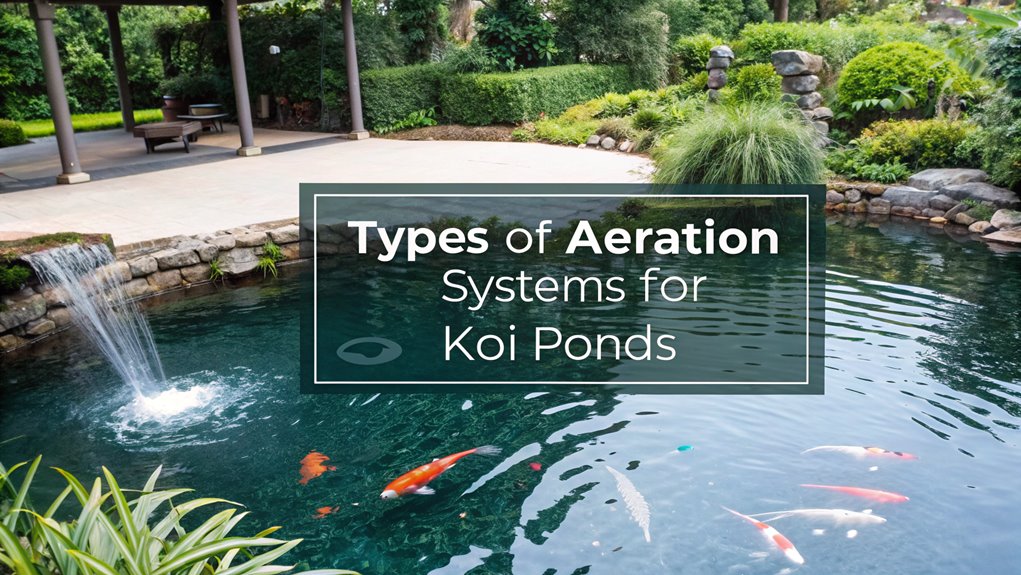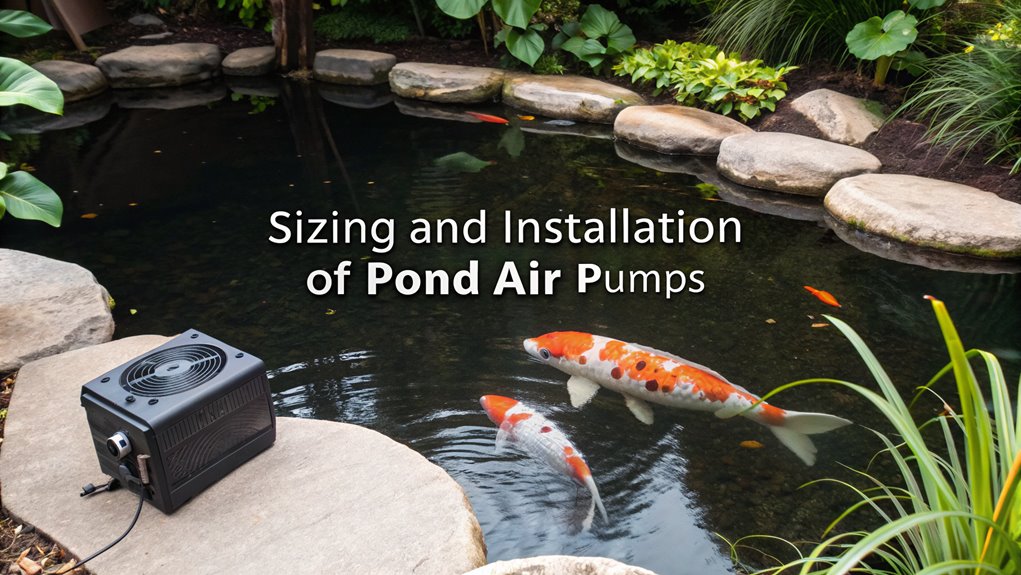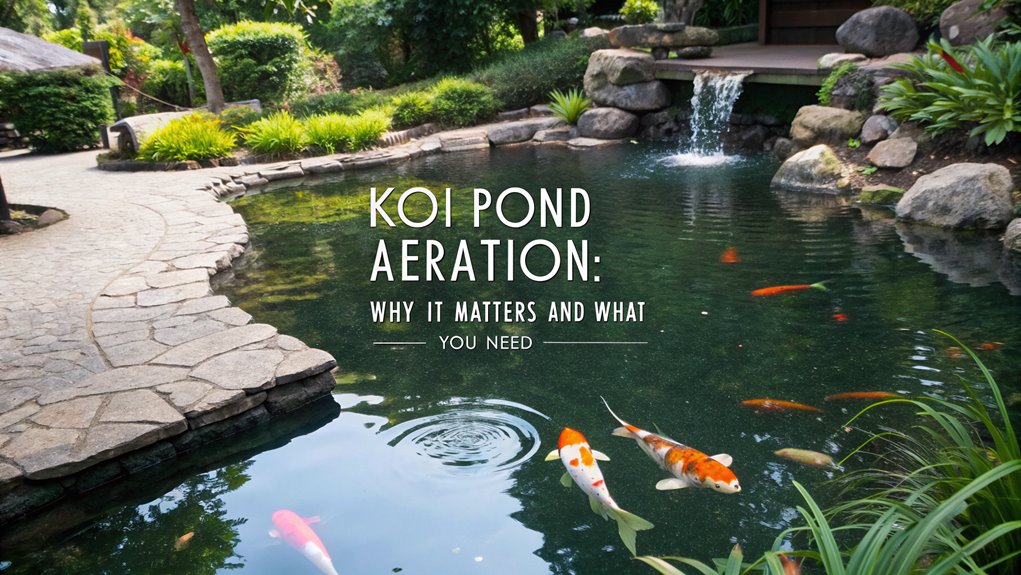Aerating your koi pond is crucial for maintaining high dissolved oxygen levels, vital for fish health and beneficial bacteria. Choose from surface aerators for ponds up to 10 feet deep, or opt for energy-efficient bottom diffusion systems to improve circulation and reduce sediment buildup. Proper sizing and installation help you prevent fish kills, algae growth, and stagnant zones. Achieving optimal aeration enhances your pond ecosystem’s stability and clarity, ensuring your koi thrive throughout the seasons. Curious to enhance your pond further?
Key Facts Summarized
- Aeration boosts dissolved oxygen, crucial for koi health and beneficial bacteria in the pond ecosystem.
- It prevents fish kills and maintains oxygen levels when the primary waterfall pump is off.
- Surface and bottom diffusion aerators improve gas exchange and reduce pond stagnation.
- Proper sizing and installation of air pumps optimize aeration efficiency for different pond sizes.
- Regular maintenance of aeration systems ensures effective operation and prevents harmful anaerobic conditions.
Importance of Aeration for Koi Ponds

While you mightn’t immediately consider it, aeration plays an indispensable role in maintaining a healthy koi pond. By boosting dissolved oxygen levels, aeration supports the vitality of koi and beneficial bacteria, crucial for optimal water quality.
During hot months or within densely populated ponds, oxygen levels can plummet, precipitating fish kills from stress. An air pump ensures continuous oxygenation, even when the primary waterfall pump is inactive.
Circulating water minimizes organic debris and reduces muck, contributing to a proper aerated pond and improved water clarity. Moreover, winter aeration prevents ice formation, facilitating essential gas exchange. Maintaining adequate oxygen levels is paramount for sustaining not only the aesthetic appeal but also the ecological balance of your koi pond.
Types of Aeration Systems for Koi Ponds

When selecting an aeration system for your koi pond, it’s essential to consider both surface and bottom diffusion options, each catering to distinct pond depths and specific needs.
Surface pond aerators, like fountains, are suitable for ponds 6-10 feet deep; they enhance aesthetic appeal while maintaining oxygen in the water.
For deeper ponds, bottom diffusion aeration effectively circulates oxygen throughout the entire water column, improving water quality and clarity. This system disrupts thermocline layers, facilitating gas exchange and increasing oxygen levels.
Bottom diffusion systems are energy-efficient, reducing maintenance costs for a properly aerated pond. They ensure the entire water volume circulates every 24 hours, preventing stagnation. Additionally, selecting the right pump flow rate is crucial for achieving effective circulation and optimal oxygenation.
Choose wisely to maintain optimal pond conditions and health.
Sizing and Installation of Pond Air Pumps

In the realm of koi pond aeration, selecting the right air pump size is as critical as choosing the type of aeration system. For small ponds, a single air stone suffices, while medium ponds benefit from a two-outlet air pump. Installation is straightforward: position the air pump near the pond edge, connect tubing to an air stone placed in the pond, ensuring optimal oxygen distribution. Air pumps like the Aquascape Pro Air 60 support larger ponds by accommodating multiple air stones.
| Pond Size | Recommended Setup |
|---|---|
| Small Ponds | One air stone |
| Medium Ponds | Two-outlet pump or splitter |
| Large Ponds | Multiple air stones, large pump |
Regular maintenance, including cleaning the air stone and diaphragm replacement, ensures the aeration system functions efficiently.
Benefits of Aeration for Pond Ecosystems
Enhancing water quality through effective aeration is critical for sustaining healthy pond ecosystems. Aeration improves oxygen levels, essential for fish survival and the thriving of beneficial aerobic bacteria that decompose organic matter.
By addressing excess nutrients and reducing muck accumulation, aeration limits algae growth, enhancing water clarity and aesthetics. A well-functioning pump ensures consistent water temperature, stabilizing conditions for aquatic life and minimizing stress on fish.
Moreover, aeration prevents stagnant areas, reducing mosquito breeding sites and promoting a more enjoyable environment. Aeration’s role in preventing harmful anaerobic conditions is vital, especially during seasonal temperature shifts and winter ice coverage.
Maintenance and Operating Guidelines for Aeration Systems
Aeration systems play a pivotal role in maintaining the vitality of pond ecosystems, as previously highlighted.
To optimize oxygen levels, aim to circulate the entire volume of water to the surface every 24 hours. This process reduces stagnation and supports aerobic bacteria essential for healthy ecosystems.
Ensure your air pump provides adequate psi based on water depth for efficient diffusion. A well-calibrated pond aerator helps prevent turbidity, preserving water clarity and quality.
During winter months, maintaining open water areas facilitates gas exchange, crucial in preventing winterkill among live organisms. Operating your system 24/7, especially in warmer periods, is recommended to counteract significant oxygen level drops. Regularly checking water quality parameters is essential to monitor the effectiveness of your aeration system.
Consistent maintenance of these systems ensures they perform optimally, safeguarding your pond’s health.
Frequently Asked Questions
Do I Need an Aerator for My Koi Pond?
Yes, you need an aerator. It maintains optimal oxygen levels, especially crucial in high fish populations. Data indicates aeration reduces stress and mortality rates by enhancing gas exchange and nutrient distribution, preventing harmful bacteria proliferation and foul odors.
Are Pond Aerators Worth It?
Imagine your koi pond as a bustling city; aerators are its oxygen-rich highways, preventing traffic jams or stagnant zones. They’re worth it, maintaining stable oxygen levels and reducing algae, ultimately ensuring a thriving aquatic ecosystem.
What Are the Disadvantages of Pond Aeration?
You’re considering pond aeration, but watch for disadvantages: excessive agitation disturbs fish, high initial costs, ongoing maintenance, uneven oxygen distribution, and potential rapid oxygen depletion in extreme temperatures. Balance these factors with benefits to make informed decisions.
Can You Aerate a Koi Pond Too Much?
Imagine 80% of koi stress from over-aeration. You can aerate too much, causing stress and reducing water clarity. Monitor dissolved oxygen levels and adjust aeration to maintain optimal conditions, ensuring koi thrive without excess turbulence.
Conclusion
In the grand tapestry of your koi pond ecosystem, aeration is the thread that weaves life, vitality, and balance. By choosing the right aeration system and ensuring proper installation and maintenance, you’re not just enhancing water quality but also promoting the well-being of your koi. With data supporting improved oxygen levels and reduced harmful gases, your pond becomes a thriving sanctuary. Dive into this commitment, and your koi will thank you with vibrant health and beauty.


